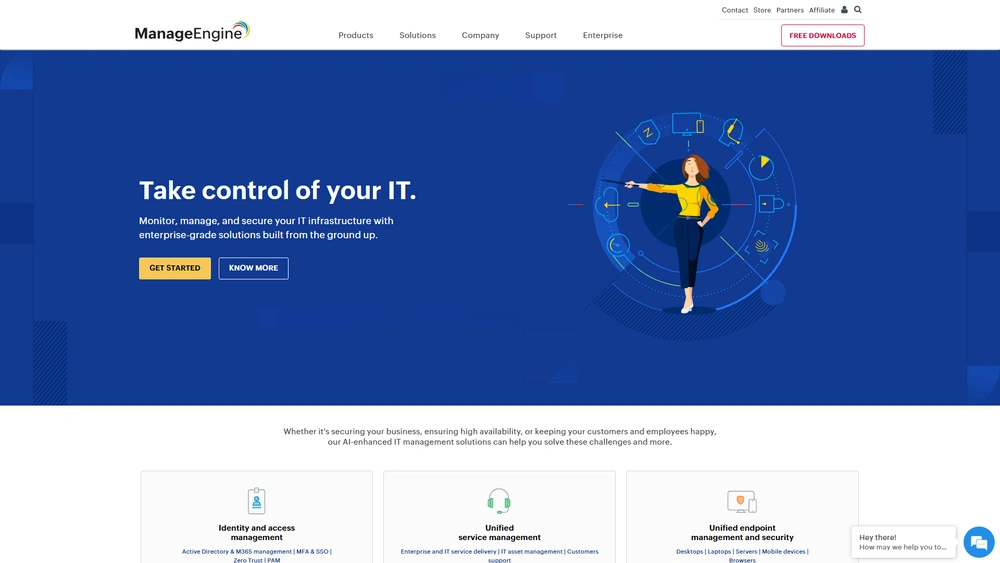ManageEngine Overview & 2025 Industry Position
ManageEngine, the enterprise IT management division of Zoho Corporation, has steadily become a cornerstone for businesses seeking robust, scalable, and affordable IT solutions. In 2025, it stands at the forefront of digital transformation, offering more than 60 enterprise-grade tools spanning IT operations, service management, endpoint security, and analytics. With AI-driven automation, full-stack observability, and a flexible on-premise/cloud/hybrid model, ManageEngine continues to rival major players like ServiceNow, SolarWinds, and Ivanti—often at a better value.
From Launch to 2025: ManageEngine’s Journey
Originally launched in 2001 by Zoho Corporation, ManageEngine began with a vision to deliver enterprise IT tools accessible to growing businesses. Its early success came with OpManager (network monitoring) and ServiceDesk Plus (ITSM), later expanding into identity management, log analytics, and unified endpoint management.
- 2005: Released ServiceDesk Plus—gaining widespread midmarket adoption.
- 2010: Introduced Applications Manager—expanding into APM.
- 2015: Added ADSelfService Plus, entering IAM (identity access management).
- 2020: Launched AI-enabled IT automation across core products.
- 2023: Integrated full-stack observability via Site24x7 alignment.
- 2025: Unified analytics renamed to “Zia Insights,” powered by Zoho’s deep learning engine.
ManageEngine’s 2025 strategy: Positioned as the “affordable enterprise stack,” it focuses on advanced automation, AI observability, and modular licensing for hybrid cloud IT shops.

ManageEngine Key Features
ManageEngine’s modular offerings cover a wide swath of IT domains. Here are standout products and attributes defining the 2025 experience:
- ServiceDesk Plus: ITIL-compliant service desk platform with AI-assisted ticket routing.
- OpManager: Real-time network monitoring with topology maps, config backups, and NetFlow analysis.
- Endpoint Central (UEM): Unified endpoint management for Windows, macOS, Linux, iOS & Android.
- Log360: SIEM solution with UEBA and cloud-native log analytics.
- ADManager/ADAudit/ADSelfService Plus: Full Active Directory suite with automation and compliance reports.
- Analytics Plus: Cross-platform BI for IT – now includes Zia Insights (AI explanations).
Workflow & UX
While ManageEngine tools vary by module, the visual language and UX have been harmonized in recent years to improve onboarding and daily use:
- Unified navigation panels across major apps (e.g., ServiceDesk, OpManager, Applications Manager).
- Zia Assistant delivers context-aware AI prompts to help automate repetitive workflows.
- Drag-and-drop dashboards allow tailored visualizations for devices, apps, logs, or workflows.
- User role-based access: High control without scripting—intuitive policy assignments via GUI.
- Low-code customization: Custom forms, triggers, and reports using built-in widgets and logic flows.
Pro Tip: Bundle 2–3 modules for unified licensing and dashboard sync, especially for SME or mid-market IT teams seeking budget optimization.
ManageEngine Pricing Analysis & Value Metrics
ManageEngine offers perpetual licenses and annual subscriptions across various modules. Pricing shown as of July 2025 (quoted in USD):
| Product | Plan | Pricing | Includes |
|---|---|---|---|
| ServiceDesk Plus | Standard | $495/year (5 techs) | Basic ticketing, asset mgmt |
| Enterprise | $1,195/year | ITIL, automation, CMDB, CSP | |
| OpManager | Professional | $945/year (25 devices) | Perf. monitors, SNMP, NetFlow |
| Endpoint Central | Free | $0 (up to 25 endpoints) | Unified endpoint config tools |
| Enterprise | $795/year (50 endpoints) | Patch mgmt, mobile + OS support | |
| Analytics Plus | Pro | $2,395/year | Reports, dashboards, Zia Insights |
Value Summary: ManageEngine delivers consistent ROI for SMBs and mid-markets. Enterprise orgs benefit from modular pricing—but may need additional licenses for high-scale redundancy or compliance needs.
Competitive Landscape
ManageEngine competes with leaders across categories:
| Brand | Strengths | Weaknesses | Ideal For |
|---|---|---|---|
| ManageEngine | Affordable, modular, wide IT coverage | UI variance, modular complexity | SMB to Mid-Enterprise |
| ServiceNow | Enterprise ITSM, integrations | Expensive, overkill for SMBs | Large Enterprise |
| SolarWinds | Robust NOC/monitoring | Security scrutiny, less UI polish | IT admins, MSPs |
| Ivanti | Strong endpoint & security | Complex setup, enterprise focus | Secure enterprise environments |
Use Cases
- MSPs managing SMB clients’ entire IT stack.
- Educational institutions managing student/faculty endpoints and help desk.
- Healthcare networks needing HIPAA-compliant AD control & incident tracking.
- Mid-market SaaS firms scaling ITSM and monitoring rapidly.
- Government agencies standardizing logs and patching across hybrid datacenters.
Integrations & Ecosystem
ManageEngine supports 200+ integrations including:
- ITSM/DevOps – Jira, Freshservice, Zendesk, BMC.
- Identity/SSO – Azure AD, Okta, Google Workspace, Duo.
- Cloud Infra – AWS, Azure, GCP, Kubernetes.
- Security – Splunk, Palo Alto, Fortinet, Qualys.
- Productivity – Microsoft 365, Dropbox, Slack, Teams.
Modules API-first design with REST/Webhooks ensures scalable automation capability for enterprise IT workflows.
Pros & Cons
- Pros:
- Affordable, scalable product ecosystem.
- Clean UI—consistent improvements since 2023.
- Excellent support documentation and forums.
- Free tiers available for many modules.
- Cons:
- Modules sold separately—can inflate cost if not bundled smartly.
- Learning curve when adopting 3+ tools simultaneously.
- Some lag in UI refresh for lower-tier tools.
Final Thoughts
If you’re seeking enterprise-grade features without enterprise pricing, ManageEngine belongs on your 2025 shortlist. The modular stack lets SMBs scale thoughtfully, and enterprises deploy strategically across IT domains. However, success depends on selecting the right products and configuring integrations. Best fit: growing teams with in-house IT; less ideal for code-phobic orgs needing turnkey simplicity.
ManageEngine FAQ
ManageEngine offers IT management tools spanning service desks, asset monitoring, endpoint security, identity access control, and analytics—typically used by IT operations teams.
Yes. Many of its tools offer on-premise, cloud, or hybrid deployment—making it flexible for organizations mid-way in their cloud migration journey.
OpManager focuses on network and server monitoring, while ServiceDesk Plus is an ITIL-compliant ticketing and service request platform—both often used together.
ManageEngine offers many similar ITSM and ITOM features at a significantly lower cost, but ServiceNow leads in enterprise-scale integrations and high-end automation.
Yes. Many tools including Endpoint Central, OpManager, and ServiceDesk Plus offer limited free editions—ideal for startups or testing use cases.